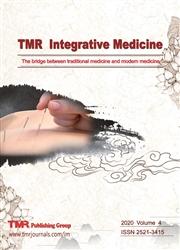Mechanic study of Qushi Kaiyu decoction on non-alcoholic fatty liver disease model rats based on the inhibition of TLR4/NF-ĸB pathway
引用次数: 0
Abstract
Background: The objective of this research was to examine the impact of the Chinese herbal formula Qushi Kaiyu (QSKY) on rats with non-alcoholic fatty liver disease (NAFLD) and its inhibitory effect on the TLR4/NF-ĸB pathway. Methods: NAFLD model rats was constructed through high-fat diet. Meanwhile, rats were treated with QSKY (6.4 g/kg) by gavage. The therapeutic effect of QSKY on NAFLD was assessed by testing body weight change, the liver index, lipid concentrations in blood, and antioxidant and inflammatory levels; assessing liver function; and performing pathological staining including hematoxylin-eosin and Oil Red O. The protein levels of key factors in the TLR4/NF-ĸB pathway (TLR4, MyD88, p65 and IKB) in rat liver tissue were determined using western blotting in order to explore the mechanism responsible for the therapeutic effects of QSKY in rats with NAFLD. Results: QSKY significantly reduced the liver index and body weight value; reduced triglyceride, cholesterol, alanine aminotransferase, and aspartate aminotransferase levels in NAFLD rats; improved the pathological changes, such as ballooning degeneration, fat accumulation, necrosis, and inflammation; elevated GSH-Px and superoxide dismutase activities and lowered malondialdehyde levels, indicating that QSKY enhanced the antioxidant capacity; and reduced inflammatory cytokine (IL-6, IL-1β, and TNF-α) levels. Western blotting results showed that QSKY significantly reduced TLR4, MyD88, and decreased the phosphorylation of IKB and p65 protein levels in the livers of rats with NAFLD. Conclusions: QSKY showed therapeutic effects on NAFLD and can alleviate oxidative stress and inflammation. This mechanism may be related to an improvement in TLR4/NF-ĸB pathway.祛湿开瘀汤对非酒精性脂肪肝模型大鼠TLR4/NF-ĸB通路抑制的机制研究
背景:本研究旨在探讨中药祛湿开郁方(QSKY)对非酒精性脂肪性肝病(NAFLD)大鼠的影响及其对TLR4/NF-ĸB通路的抑制作用。方法:采用高脂饮食法建立NAFLD模型。同时,给大鼠灌胃6.4 g/kg的QSKY。通过测定体重变化、肝脏指数、血脂浓度、抗氧化水平和炎症水平来评价QSKY对NAFLD的治疗效果;评估肝功能;采用western blotting检测大鼠肝组织TLR4/NF-ĸB通路关键因子(TLR4、MyD88、p65、IKB)蛋白水平,探讨QSKY对NAFLD大鼠治疗作用的机制。结果:QSKY可显著降低肝脏指数和体重值;NAFLD大鼠甘油三酯、胆固醇、丙氨酸转氨酶和天冬氨酸转氨酶水平降低;改善水肿变性、脂肪堆积、坏死、炎症等病理改变;提高GSH-Px和超氧化物歧化酶活性,降低丙二醛水平,表明QSKY增强了抗氧化能力;降低炎症细胞因子(IL-6、IL-1β和TNF-α)水平。Western blotting结果显示,QSKY显著降低了NAFLD大鼠肝脏中TLR4、MyD88的磷酸化水平,降低了IKB和p65蛋白的磷酸化水平。结论:QSKY对NAFLD有治疗作用,可减轻氧化应激和炎症反应。这一机制可能与TLR4/NF-ĸB通路的改善有关。
本文章由计算机程序翻译,如有差异,请以英文原文为准。
求助全文
约1分钟内获得全文
求助全文

 求助内容:
求助内容: 应助结果提醒方式:
应助结果提醒方式:


